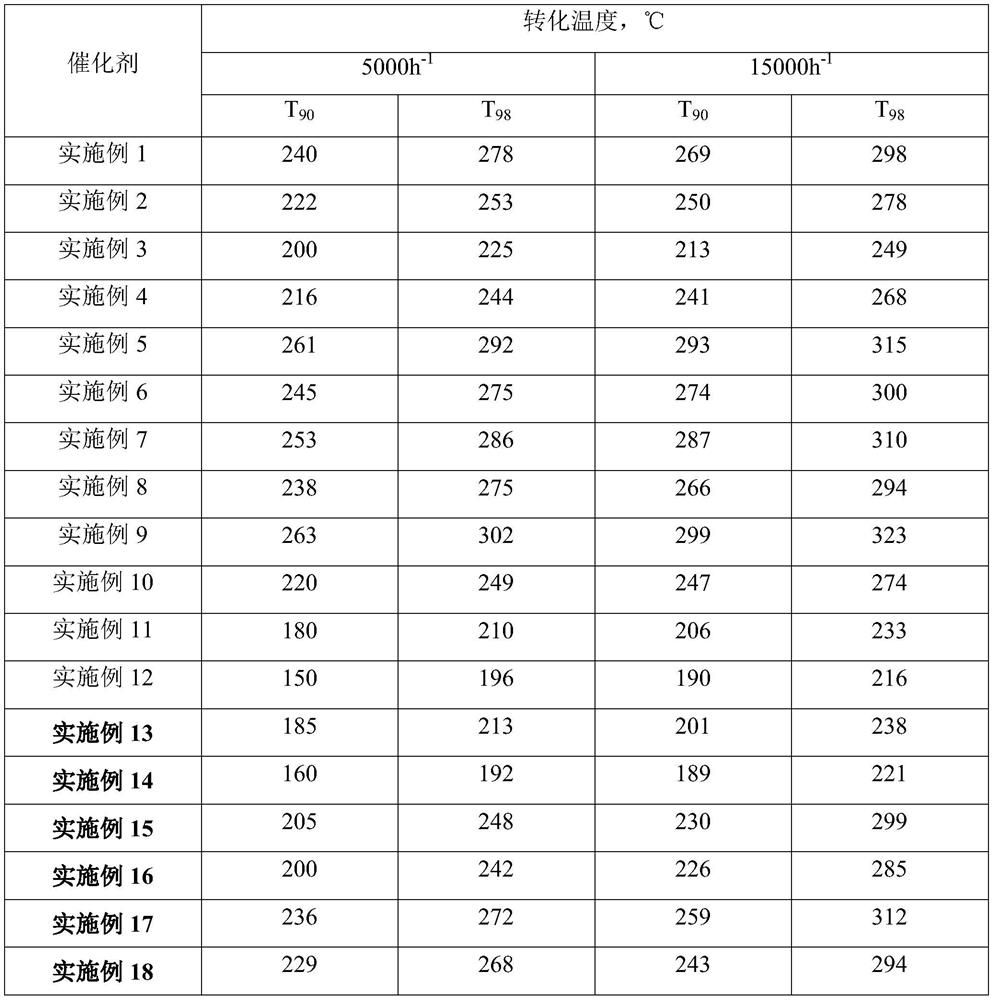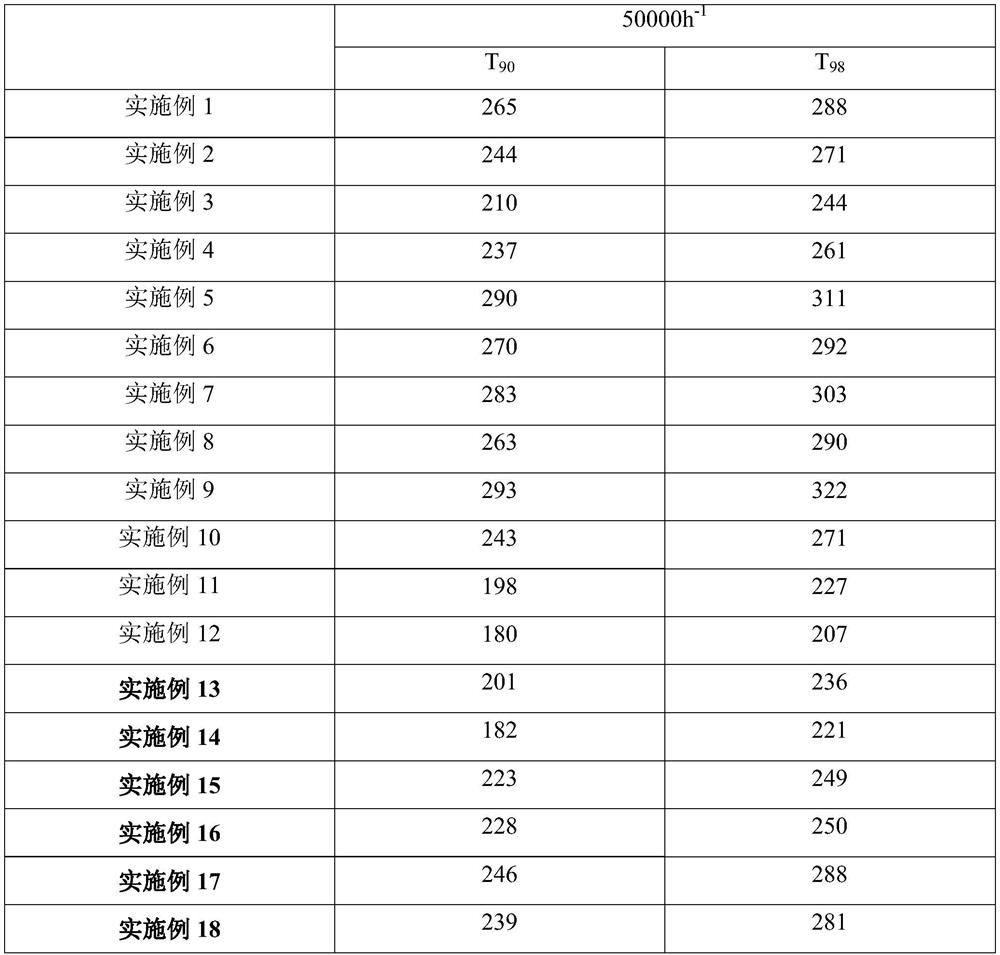Low-temperature HVOCs catalytic combustion catalyst and preparation method and application thereof
A catalytic combustion and catalyst technology, applied in catalyst activation/preparation, combustion methods, physical/chemical process catalysts, etc., can solve the problems of high reaction temperature, high load, ≥350 °C, etc. The effect of low temperature and high efficiency treatment and good stability
- Summary
- Abstract
- Description
- Claims
- Application Information
AI Technical Summary
Problems solved by technology
Method used
Image
Examples
Embodiment 1
[0073] Dissolve 10.0 grams of copper nitrate in 30.0 milliliters of pure water, add 60.0 grams of rutile titanium dioxide, 40.0 grams of gamma alumina, and 2.0 grams of scallop powder, and knead evenly.
[0074] Extrude to obtain strips, and dry in air at 120° C. for 2 hours to obtain dried strip carriers.
[0075] The dried carrier was dry-calcined in air at 300° C. for 4 hours to obtain a calcined strip-shaped carrier.
[0076] Take 50 grams of the calcined carrier, impregnate it with 25 milliliters of ruthenium chloride solution containing 0.1 gram of Ru, and dry it at 120° C. for 2 hours to obtain a dried catalyst.
[0077] The dried catalyst was dry-calcined in air at 300° C. for 4 hours. The catalyst has a surface area of 100 m 2 / g, the pore size is 0.02um.
[0078] Dissolve 0.6g of hydrazine hydrate in 100g of 1mol / L sodium hydroxide solution, add the calcined catalyst to the above mixed solution for treatment for 30min, then wash until neutral, then dry at 60°C f...
Embodiment 2
[0081] Take metatitanic acid containing 100.0 grams of titanium dioxide, add 2.0 grams of methylcellulose, 40.0 milliliters of pure water, and knead evenly.
[0082] Extrude to obtain strips, and dry in air at 120° C. for 4 hours to obtain dried strip carriers.
[0083] The dried carrier was dry-calcined in air at 450° C. for 4 hours to obtain a calcined strip-shaped carrier.
[0084] Take 50 g of the calcined carrier, impregnate it with 25 ml of ruthenium nitrate solution containing 0.2 g of Ru, and dry it at 120° C. for 6 hours to obtain a dried catalyst.
[0085] The dried catalyst was dry-calcined in air at 300°C for 4 hours. The catalyst has a surface area of 85 m 2 / g, the pore size is 0.1um.
[0086] Dissolve 0.6g of hydrazine hydrate in 100.0g of 1mol / L sodium hydroxide solution, add the calcined catalyst to the above mixed solution for treatment for 30min, then wash until neutral, then dry at 60°C for 12h, Calcined at 200°C for 2 hours to obtain the catalyst pro...
Embodiment 3
[0089] Dissolve 34 grams of cerium nitrate in 21.0 milliliters of pure water, add 60.0 grams of 20% rutile-type titanium dioxide, 40.0 grams of gamma alumina, and 2.0 grams of squash gum, and knead evenly.
[0090] Extrude to obtain strips, and dry in air at 120° C. for 8 hours to obtain dried strip carriers.
[0091] The dried carrier was calcined in air at 500°C for 3 hours to obtain a calcined strip-shaped carrier.
[0092] 50.0 g of the calcined carrier was taken, impregnated with 30 ml of ruthenium nitrate solution containing 5.0 g of Ru, and dried at 120° C. for 10 hours to obtain a dried catalyst.
[0093] The dried catalyst was dry-calcined at 350° C. in air for 2 hours. The surface area of the catalyst is 80m 2 / g, the pore size is 0.2um.
[0094] Dissolve 2.0g of hydrazine hydrate in 150g of 0.6mol / L sodium hydroxide solution, add the calcined catalyst to the above mixed solution for treatment for 60min, wash until neutral, then dry at 80°C for 10h, and then dry...
PUM
| Property | Measurement | Unit |
|---|---|---|
| Surface area | aaaaa | aaaaa |
| Aperture | aaaaa | aaaaa |
| Surface area | aaaaa | aaaaa |
Abstract
Description
Claims
Application Information
 Login to View More
Login to View More - R&D
- Intellectual Property
- Life Sciences
- Materials
- Tech Scout
- Unparalleled Data Quality
- Higher Quality Content
- 60% Fewer Hallucinations
Browse by: Latest US Patents, China's latest patents, Technical Efficacy Thesaurus, Application Domain, Technology Topic, Popular Technical Reports.
© 2025 PatSnap. All rights reserved.Legal|Privacy policy|Modern Slavery Act Transparency Statement|Sitemap|About US| Contact US: help@patsnap.com



